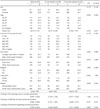Abstract
Objectives
This study was conducted to evaluate the effectiveness of a suicide prevention advertising media campaign by the Korea Suicide Prevention Center in 2014 and to analyze the changes in the levels of suicide prevention related-knowledge, attitude, and behavior of the advertisement viewers.
Methods
Data of 703 participants who responded to both the pre and post telephone surveys out of 1100 adults aged 19 or over randomly selected nationwide were analyzed using a stratified proportional quota sampling method considering sex, age, and region by a survey agency. A propensity score matching (PSM) analysis was used to adjust for potential biases in estimated effects.
Results
Of 703 participants who completed pre and post survey interviews, 25.9% watched the media campaign. Comparing the knowledge, attitude, and behavior scores between the advertisement viewers (n=182) and non-viewers (n=521), of those who watched the media campaign, participants' knowledge score showed a statistically significantly increase in all methods of the PSM analysis while there were no statistically significant changes in attitude and behavior.
Acknowledgments
Authors thank Mr. Lee Je Seok for his talent donation to make the suicide prevention TV advertisement.
References
1. Korean Statistical Information Service [homepage on the Internet]. Causes of mortality. Daejeon: Statistics Korea;updated 2014 Sep 23. cited 2014 Dec 23. Available from: http://kosis.kr/statHtml/statHtml.do?orgId=101&tblId=DT_1B34E01&vw_cd=MT_ZTITLE&list_id=D11&seqNo=&lang_mode=ko&language=kor&obj_var_id=&itm_id=&conn_path=E1.
2. OECD.Stat [homepage on the Internet]. OECD Health Data 2014: Causes of mortality. Paris: Organization for Economic Co-operation and Development;updated 2014 Jun. cited 2014 Dec 23. Available from: http://stats.oecd.org/index.aspx?DataSetCode=HEALTH_STAT.
3. Kwon JR. Effect of Public Campaign through Mass Media. Korean J Journal Commun Stud. 1995; 33:5–31.
4. Kwon JR. Cultural Values and Creative strategies expressed in public service advertising. Advert Res. 2002; 56:127–159.
5. Han KT, Ma JM. A study on effective strategy of public health campaign message in Korea. Advert Res. 2000; 47:7–35.
6. Wakefield MA, Loken B, Hornik RC. Use of mass media campaigns to change health behaviour. Lancet. 2010; 376:1261–1271.

7. Song IH, Kang YH, Kim DH, Park IJ, Park JI, Lee MS, et al. Developing suicide prevention campaign and messages in the context of Korea [research report funded by Ministry of Health & Welfare]. Seoul: Office of Research Affairs, Yonsei University;2013.
8. Dumesnil H, Verger P. Public awareness campaigns about depression and suicide: a review. Psychiatr Serv. 2009; 60:1203–1213.

9. du Roscoät E, Beck F. Efficient interventions on suicide prevention: a literature review. Rev Epidemiol Sante Publique. 2013; 61:363–374.

10. Song IH, Kwon SW, Kim JS, You JW, Park JH, Kim L, et al. Cross-national comparison of public awareness campaigns for suicide prevention: analysis of campaign strategies and contents of New Zealand, USA, Ireland, Scotland, Australia, and Korea. J Korea Contents Assoc. 2014; 14:253–270.

11. Kim JH, Kim BH. A study on the public service advertising for influenza prevention: focused on the audience characteristics. J Pract Res Advert Public Relat . 2010; 3:156–176.
12. Kobaco [homepage on the Internet]. AD information. Seoul: Korea Broadcast Advertising Corp;cited 2014 Dec 23. Available from: https://www.kobaco.co.kr/businessintro/about/about_view.asp.
13. Perkins HW, Linkenbach JW, Lewis MA, Neighbors C. Effectiveness of social norms media marketing in reducing drinking and driving: a statewide campaign. Addict Behav. 2010; 35:866–874.

14. Sly DF, Hopkins RS, Trapido E, Ray S. Influence of a counteradvertising media campaign on initiation of smoking: the Florida "truth" campaign. Am J Public Health. 2001; 91:233–238.

15. You HS. The analytical study on the effect of TV anti-smoking PSA (Public Service Announcement) [dissertation]. Seoul: Yonsei University;2003.
16. Kim JS, Song IH. Comparison of national strategies for suicide prevention: national strategies of New Zealand, USA, Ireland, England, Scotland, Australia, and Korea analyzed based on the WHO framework. Health Soc Welf Rev. 2013; 33:513–554.

17. Klimes-Dougan B, Klingbeil DA, Meller SJ. The impact of universal suicide-prevention programs on the help-seeking attitudes and behaviors of youths. Crisis. 2013; 34:82–97.

18. Jenner E, Jenner LW, Matthews-Sterling M, Butts JK, Williams TE. Awareness effects of a youth suicide prevention media campaign in Louisiana. Suicide Life Threat Behav. 2010; 40:394–406.

19. Oliver RJ, Spilsbury JC, Osiecki SS, Denihan WM, Zureick JL, Friedman S. Brief report: preliminary results of a suicide awareness mass media campaign in Cuyahoga County, Ohio. Suicide Life Threat Behav. 2008; 38:245–249.

20. Till B, Sonneck G, Baldauf G, Steiner E, Niederkrotenthaler T. Reasons to love life. Effects of a suicide-awareness campaign on the utilization of a telephone emergency line in Austria. Crisis. 2013; 34:382–389.
21. Klimes-Dougan B, Yuan C, Lee S, Houri AK. Suicide prevention with adolescents: considering potential benefits and untoward effects of public service announcements. Crisis. 2009; 30:128–135.
22. Klimes-Dougan B, Lee CY. Suicide prevention public service announcements: perceptions of young adults. Crisis. 2010; 31:247–254.
23. Chang WS, Yang YJ. Study on the development of public service advertising system in the era of smart media [research report of the Korea Broadcast Advertising Corps.]. Seoul: Kobaco;2013.
24. MacCann C, Roberts RD. Development of a student health assessment system: health knowledge, attitudes, and behaviors in middle-school students. ETS Res Rep Ser. 2014; 2010:i–42.

26. Freimuth VS, Quinn SC. The contributions of health communication to eliminating health disparities. Am J Public Health. 2004; 94:2053–2055.

27. World Health Organization [homepage on the Internet]. Health education. Geneva: WHO;cited 2014 Dec 23. Available from: http://www.who.int/topics/health_education/en/.
28. Moon JS. Compare the knowledge, attitude and behavior about smoking in the elementary students according to anti-smoking education. Korean J Child Health Nurs. 2004; 10:59–65.
29. Bettinghaus EP. Health promotion and the knowledge-attitude-behavior continuum. Prev Med. 1986; 15:475–491.

30. Choi K. An analysis on the policy evaluation method in the labor market. J Employ Skills Dev. 2007; 10:181–202.

31. Kim YS, Kang EN. A study on the effects of health promotion of the elderly employment promotion projects for the elderly: by using propensity score matching. Korean J Local Gov Adm Stud . 2011; 25:419–435.

32. Suh MK. Evaluation of 2005 governmen-driven anti-smoking. Korean Society for Health Education and Promotion. Cheonan: Korean Society for Health Education and Promotion;2006. p. 4–28.




 PDF
PDF ePub
ePub Citation
Citation Print
Print




 XML Download
XML Download